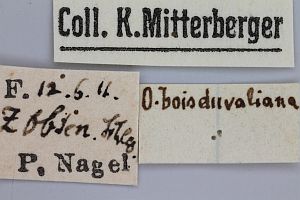

 +15Kontinente:EU
+15Kontinente:EU2. Diagnose
2.1. Geschlecht nicht bestimmt
2.2. Erstbeschreibung
3. Biologie
3.1. Nahrung der Raupe
- [Fabaceae:] Trifolium pratense (Rot-Klee, Roter Wiesen-Klee)
Kennel (1921: 427) hatte formuliert: "Die Raupe von Heinemann an Pinus abies [sic!] vermutet".
Schütze (1931: 32) schrieb zur Raupe knapp: "An Picea abies (Sorhagen). Weiteres nicht bekannt. Norddeutschland." Wahrscheinlich stimmte nichts von alledem, doch auch bei Razowski (2001: 68) heißt es noch immer einfach "Picea".
Välimäki & Itämies (2002) studierten die Art in Finnland, wobei sie erst einmal die Literaturangaben zur Raupe zusammentrugen: "Only fragmentaryinformation about the ecology of C. boisduvaliana has been available. Old lepidopterologists have known how and where to search for it, but exact literature has been missing. Hannemann (1961) presumes it to live on Norwegian spruce (Picea abies (L.) Karsten). This may be based on Schütze (1931), who cited it from Sorhagen (1886). Kennel (1921) assumes the species to feed on Pinus abies [sic!]. Ryrholm & Ohlsson (1999), on the other hand, suppose its larvae to live on Alpine bistort (Polygonum viviparum L.)." Im Bereich der aktuellen Fundstelle in Finnland gab es zwar Fichten und Kiefern in der Nähe, aber die Falter wurden inmitten der Wiese gefunden, so dass auch die Raupen dort zu erwarten waren. Und tatsächlich: "At first, we searched for larvae quite randomly nearthe places where most of the imagos had been collected in previous years. Small larvae were found within silken webbing around Trifolium pratense. Because the larvae looked like typical tortricoid larvae, the search was concentrated mostly around T. pratense. The first attempt produced eight larvae, and some more were found later. The larvae were then brought into a laboratory and kept in jars with fresh T. pratense. After a couple of weeks, when the first adult emerged, it was ensured that they represented C. boisduvaliana. The larvae spin a silken tube and webbing around the lower parts of Trifolium pratense, lying close to ground among the litter. The tube is about 2 cm long and rather weak at first, i.e. if handled roughly, it could easily break. When disturbed, the larva crawls quickly backwards and escapes from the tube among the litter. The larvae feed on lower leaves and probably also other green parts of T. pratense. In the final phase the webbing covers almost the whole base of the foodplant. The larvae usually occurred solely on plants growing singly in open or semiopen areas (zones 1–2 in Fig. 3). This points out the necessity of dry and open meadows for the survival of this species. Pupation takes place in the tube. The larva is dark grey with a black head capsule." Diese detaillierte Beschreibung legt nahe, dass alle anderen Angaben falsch sind.
(Autor: Erwin Rennwald)
4. Weitere Informationen
4.1. Andere Kombinationen
- Carpocapsa boisduvaliana Duponchel, [1836] [Originalkombination]
- Phiaris boisduvaliana Duponchel, [1836] [so bei Kennel (1921)]
4.2. Faunistik
Nach der [Fauna Europaea] kommt die Art in Schweden, Finnland, Estland, Lettland, Litauen, Deutschland, Frankreich, Italien einschließlich Sizilien, Polen, Ungarn, Bulgarien, Rumänien, in der Slowakei sowie in Nordwest-Russland vor. Nach Gaedike und Heinicke (1999) kommt die Art in Deutschland nicht vor. Nach den Ausführungen von Steiner in Gaedike et al. (2017: 265) gehören die alten Meldungen zu Deutschland heute zum Baltikum und / oder zu Polen.
(Autor: Erwin Rennwald)
4.3. Publikationsjahr der Erstbeschreibung
Woodward (1922: 379) [Digitalisat auf biodiversitylibrary.org] teilt die Publikationsjahre des Bandes mit. Demnach sind die Seiten 1-64 und die Tafeln 239-240 1834 erschienen, die Seiten 65-320 und die Tafeln 241-256 1835, und die Seiten 321-[627] sowie die Tafeln 257-266 1836.
(Autor: Jürgen Rodeland)
4.4. Literatur
- Erstbeschreibung: Godart, J.-B. & P.-A.-J. Duponchel (1834-[1836]): Histoire naturelle des lépidoptères ou papillons de France. Tome neuvième: 1-626, [627], pl. CCXXXVII-CCLXVI. Paris (Méquignon-Marvis).
- Hannemann, H. J. (1961): Kleinschmetterlinge oder Microlepidoptera I. Die Wickler (s. str.) Tortricidae. —Die Tierwelt Deutschlands 48: 1–233. [Sekundärzitat]
- Kennel, J. (1908-1921): Die Palaearktischen Tortriciden. Eine monographische Darstellung mit 24 Tafeln im Farbendruck, einer Stammtafel und mehreren Abbildungen im Text. — Zoologica 21 (54): 1-546, 729-742, Stammtafel, Taf. I-XXIV. Stuttgart. [Digitalisat auf biodiversitylibrary.org]
- Ryrholm, N. & A. Ohlsson (1999): Intressanta fynd av fjällfjärilar i Sverige 1998. — Entomologisk Tidskrift, 120 (1–2): 43–53. [In Swedish with English summary]. [PDF auf researchgate.net]
- [SCHÜTZE (1931): 32]
- Sorhagen, L. (1886): Die Kleinschmetterlinge der Mark Brandenburg und einiger angrenzender Landschaften. Mit besonderer Berücksichtigung der Berliner Arten. - I-X, 1-367, Corrigenda; Berlin (R. Friedländer & Sohn). [Sekundärzitat]
- Välimäki, P. & J. Itämies (2002): Occurrence and experimental introduction of Capricornia boisduvaliana (Duponchel, 1836) (Lepidoptera: Tortricidae) in Finland. — Entomologica Fennica 13 (2): 89-97. [PDF auf journal.fi]
- Woodward, B. B. (1922): Catalogue of the Books, Manuscripts, Maps and Drawings in the British Museum (Natural History). Vol. VI. Supplement: A–I: i-iv, 1-511, 1-48. London.






















